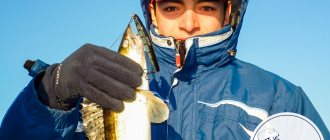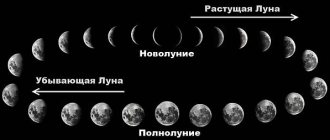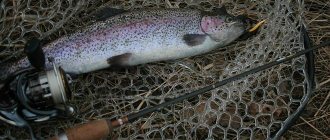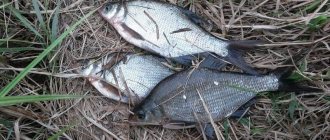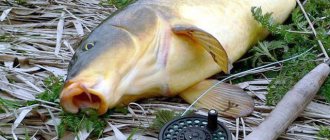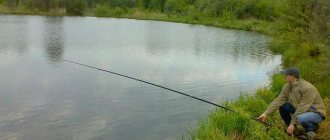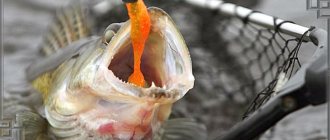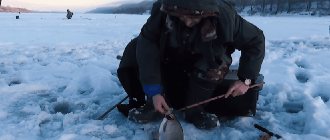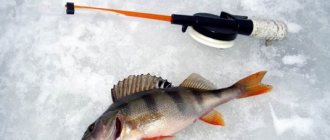Fishing for bream is an intellectual type of hunting that requires experience, observation and patience from the angler to achieve significant results, expressed in the material component of the catch and satisfaction in the correctly chosen strategy for conducting a fishing session. There are no beginners in catching large bream. These lucky ones are experienced fishermen with a huge amount of accumulated experience in catching carp species of fish, which they skillfully transform into catching this cunning and cautious fish.
The wide habitat of bream and their abundance have not brought amateur fishing in this direction to a leading position. First of all, this is countered by the peculiarities of the life activity of the fish species itself, and the difficulties of balancing, which make it possible to make working gear for catching bream and the optimal choice of fishing location, make it even more difficult to achieve a positive result. The vagaries of food preferences, the excessive caution of the fish and the rather long time spent preparing the fishing site, which sometimes extends for a couple of days only during the landing period, discourages anglers who expect quick results from fishing. Therefore, the most stubborn and patient bronze fish hunters, who have already unraveled the secrets of catching trophy bream, are confident in their strategies and well-chosen gear, become bream hunters.
In this article we will highlight some of the intricacies of organizing and conducting fishing for this mysterious, but so desirable fish, and will try to persuade those who have already been disappointed in successful attempts to catch bream on the river to take this interesting path again.
Spawning
In the spring warmth, with the warming up of reservoirs, schools of fish that have overwintered in the depths begin to move to the shallows in order to conduct noisy mating games. The spawning period lasts from mid-April to June and requires intimate places, untouched by human activity. Bream loves peace and tranquility . Even in the old days, in villages and towns close to spawning grounds, the ringing of bells was prohibited, for fear of scaring away schools of fish and thereby depriving oneself of a fishery that allowed them to feed entire settlements.
Currently, the fish spawns in quiet, shallow backwaters far from civilization with shallow vegetation on the bottom, into which eggs are deposited, and subsequently the juveniles grow there. If the school is disturbed by any activity, the fish stops spawning and goes in search of more secluded spots, without returning to the inconvenient place for several subsequent seasons. Catching bream in the spring during the spawning period is a hopeless task. Its feeding activity stops for two weeks, which the fisherman must take into account.
When does bream bite?
Excluding the period of spawning and deep winter from the annual cycle, we can confidently state that the rest of the time the fish feed regularly, but with varying intensity. Catching bream in the pre-spawning couple of weeks and at the same time after the end of the mating season is the best period for hunting in open water. Equally significant fishing results include the last ice. In general, the spring bite can be identified as the most productive of the year. With the arrival of summer, fish become unbearably capricious. Bait for bream during this period becomes the main problem that the angler needs to solve when planning a fishing trip.
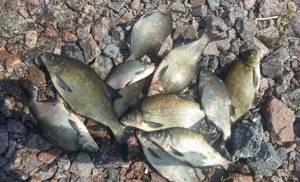
With the onset of hot periods, the bite deteriorates significantly, resuming only with cold weather and rain. Pre-storm surges of zhora are short-lived and require clear planning in choosing fishing points. From the second half of August, with the arrival of cooler nights, the bite stabilizes and lasts with equal activity until freeze-up all autumn and weakens only when, with the first serious frosts, schools of fish go for a long winter stay in the deepest places of reservoirs. Catching large bream is possible on the warm September days of Indian summer, when it reaches its last reserves of fat for the winter, feeding on zebra mussels in cooling shallow waters.
In winter, fish are not active and targeted ice fishing is mostly planned during the thaw, to catch underbream that come out onto the slopes and steps of underwater pits for short-term replenishment of spent energy reserves. Trophy specimens will stand motionless side by side in pits throughout the cold period of the year, starting to feed only with the influx of fresh melt water. Based on the daily fishing time, it is worth noting that bream fishing at night and during the day is comparable in its results and does not depend on the time of year.
Important! Regarding the selection of weather for bream fishing, I would like to note the positive factors are the stability of pressure, no matter what, but for three to four days, the presence of wind, which contributes to small waves and short-term rains.
Bream biting calendar by month
| January | February | March | April | May | June |
| — | — | + | +++ | ++ | +++ |
| July | August | September | October | November | December |
| ++ | ++ | +++ | ++ | — | — |
May
An excellent month for bream fishing. The water has reached a temperature of 11-14 degrees, which means the bream is ready to spawn. Typically, spawning begins with the opening of willow leaves. Since bream spawns at a depth of 0.5 to 1.7 meters, you need to catch it near the shore, near thickets of grass.
Bream spawns mainly on plants flooded with melt water, so choose a place based on this. Bream is very careful when eating bait; be quiet when catching it. The bite is excellent late at night and in the early morning hours.
Fish nutrition
When deciding what to use to catch large bream, an angler needs to have certain concepts about the food preferences of the fish, depending on the season of the year and the diversity of the food supply of the reservoir in which the trophy is caught. Over time, the diet of fish schools changes, adapting to the availability of the most accessible types of food. First of all, it is worth noting that according to the physiology of the structure of the oral apparatus, bream feed from the bottom, sucking up food objects with their mouth-tube.
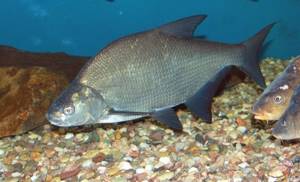
The basis of the food supply is mosquito larvae, bloodworms and coretra, as well as various types of plankton, consisting of small freshwater crustaceans. The mussel mussel zebra mussel, toothless mussel and pearl barley, if there are their colonies in the reservoir, are definitely included in the menu of this species of cyprinids. Regardless of the time of year, this food is available to schools of bream in a stable manner.
With the beginning of the spawning period of other fish species, the peace-loving bream becomes a malicious robber, willingly ruining other people's clutches of eggs and eating defenseless, clumsy juveniles. During the period of mass emergence of insects, mayfly that has reached the bottom also falls into the list of fish food. The animal origin of food is a higher priority in the menu of bream schools, but their plant species also do not go unnoticed during periods of mass entry into water bodies. The seeds of cereal plants, washed away by rains and floods, are eaten with pleasure in the same way as young shoots of aquatic bottom vegetation.
Where to catch bream
This species of carp is a schooling fish. The size of flocks can reach several hundred individuals of approximately similar size. The larger the fish, the smaller the school number. Based on these characteristics of their habitat, fish gathered in schools need large water areas with opportunities for parking and feeding areas for fish. The flocks' sites are located in parts of the reservoir remote from the shore with moderate or quiet currents and depths of three meters. Extensive holes in which water flows are slowed down by the relief structures of the bottom are ideal base points for schools of bream, which love constancy, sedentism and migrate short distances only for feeding and spawning.
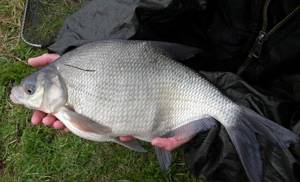
You can catch bream only on the way to the place of searching for food or directly at the feeding point. Consequently, the angler’s knowledge of the school’s movement paths is one of the foundations for successful fishing. As a rule, selected bottom plateaus with a silt layer are located at distances of up to a couple of hundred meters from the school’s parking areas. These bottom plains are associated with smooth rises to the coastlines and form shallow backwaters, fenced with thickets of reed and reed fields, where schools of bream graze, obtaining their food by digging in the silt deposits.
Important! Experienced breamers, looking for new hunting places, determine their prospects by the presence of many small air bubbles rising to the surface while a school of fish is feeding.
Clay and sand shallows inhabited by mollusk colonies will also be places of pilgrimage for schools, and the presence of a wall of coastal vegetation will only increase the chances of a promising bream point. All of the above listed signs of places suitable for fishing in most cases will require the fisherman to have a swimming device that will help to fish the selected point more effectively, and will also make it possible to get a decent distance from the shore to a remote part of the river or lake.
It is with great regret that we have to admit that in our time, catching bream from the shore is becoming a rare pleasure, due to the reduction of suitable places for fish to stay due to increased human activity, forcing bream to look for more secluded and quiet habitats away from the coastlines.
Bream on a jig
Catching bream from ice using different types of jigs increases the chances of catching even in the dead of winter. Thanks to the prostate and the effectiveness of the tackle, even a novice bream fisherman will be able to catch the coveted trophy. Also, jig fishing is ideal for fishing in a tent.
How to make tackle
To complete the jig tackle for bream you will need:
- Compact and lightweight fishing rod . The length of a durable form is 30-50 cm , it should be equipped with several passage rings, an easy-to-use handle and a spool mount.
- Medium-hard nod 15-25 cm long . A do-it-yourself watch spring nod is suitable for these purposes. The rigidity of such a spring is quite enough for timely signaling of a bite and self-hooking of bream.
- Fishing line reel . Any model will do, the main thing is that it is a reliable option.
- Monofilament thread with a cross-section of 0.1-0.17 mm . Length within 20 m . When catching a large specimen, it is recommended to choose a line that can withstand 1-1.5 kg at break . Excessively thick monofilament will only scare away cautious prey.
- Heavy tungsten jig . Considering that fishing is carried out at a fairly large depth, an actively moving bait must have serious mass in order to quickly reach a specific depth. When using bulk baits, special attention should be paid to the size of the hooks; they should freely accommodate up to 10 pieces of large bloodworms.
For information! Among the catchable models for winter bream are: uralka, reverse uralka, droplet and oatmeal. They are used together with bait. Thanks to a successful form and proper play, even the most passive prey can attract attention.
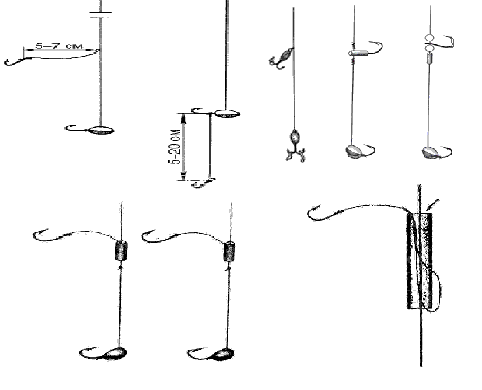
To catch bream in winter using a jig, you need to know the main points of the fishing process.
Fishing technique
The use of jig tackle involves an active search for bream. Having decided on a promising location, start feeding the holes. After which, perform a cycle of movements:
- slowly lower the jig to the bottom;
- tap several times on the bottom surface;
- raise the bait with a smooth sway of the nod.
- movements are made approximately 2-3 times per 1 second.
The signal to hook will be a straight nod on the fishing rod. It is better to use jig tackle in stagnant bodies of water and with weak currents. If ice fishing is planned on a river with a strong current, then it is more advisable to use winter feeder gear.
Video on catching bream with a jig:
What is used to catch and bite bream?
Based on your food preferences, catching bream on lakes and rivers can be successfully done with both plant and animal baits. Of particular note is the use of a combination of animal and plant composition, which sometimes significantly improves the attractiveness of the bait. The use of animal baits in the cold periods of the year has been noticed and successfully used in practice among bream fishermen. When water is heated above 20 degrees, baits of plant origin work more effectively. The only exception to the rule will be the dung worm, which can be confidently classified as a universal bream bait, equally loved by fish, regardless of the seasons. Catching large bream is closely connected with the use of a bunch of odorous dung worms, which trophy fish cannot resist in most cases. Based on the origin of the baits, let’s consider their success in the fishing process in more detail.

The best vegetable baits
Preference is given to grain crops and, above all, sweet canned corn and steamed peas. These baits are served in the form of garlands, sometimes mixing them together with five to seven large grains on the hook, covering the sting with the last link. It is appropriate, but less practical, to use wheat and oats in a similar feeding technology to the previous version of the nozzle. New potatoes, slightly undercooked, placed on a hook through a needle are no less effective than corn. Pearl barley grains, boiled until partially cooked with a hard core and soaked in attractants, attract fish throughout the summer. Flavored dough and mastyrka are used by fishermen in freshly prepared and dried form into boilies.
Best animal baits
We will not repeat ourselves about the bunch of dung worms and will immediately define maggots and bloodworms as baits that are close to universal under any fishing circumstances. The bait options available on the reservoir include small live leeches, as well as dried, to give them greater rigidity, the bodies of pearl barley mollusks and toothless mollusks, which are placed entirely on hooks and placed on the bottom. During periods of crayfish molting, large bream are caught using the meat of this arthropod, which is devoid of protection and is easily accessible to any fish.
Artificial baits
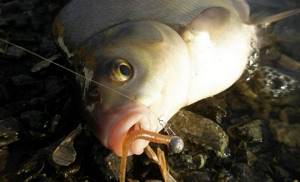
Artificial baits include silicone imitations of worms, bloodworms and maggots, made of odorous, edible rubber.
Important! This kind of bait is effective in a strong current, which, by animating it with its force, creates the illusion of using a real live bait.
Decoys in the form of plastic corn and peas require bait with strong attractants, which is why they are less popular among bream fishermen, but are useful during fish feeding, when such imitations save time on re-equipping rigs with real baits that were damaged or lost at the time of biting.
The hyperactivity of bream makes it possible to use small rotating spoons as bait when fishing with casting spinning rods. Uniform retrieval in the area of the fattening school often ends with a reliable catch of the trophy by the snout, which indicates a purposeful throw of the fish towards the bait.
Catching bream on a rocker
The bottom rig with a rocker is highly effective on bream. It is relevant not only in winter, but throughout the entire season.
What is
The equipment received its name due to its similarity with an arched wooden device - a rocker.
This method involves the use of two hooks, spaced apart at a certain distance. This placement of the bait eliminates the possibility of tangling and overlapping of the leashes with each other. loaded in the center of the rocker arm itself. For fishing in still water, a sinker of 2-3 grams . When fishing in the current, depending on the strength, from 10 grams . Hooks are used for bream and whitebait in sizes 10-12 .
This type of bottom equipment has its advantages :
- Possibility of catching bream in heavily silted areas of the reservoir.
- The tackle is unnoticeable to the eyes of the fish, the leashes are not pulled, and the prey does not feel resistance at the time of the bite.
- Thanks to two hooks, you can quickly decide on a catchable bait option.
- The bait always remains in the bream's field of vision.
- Ideal for catching large specimens that have a heightened sense of danger.
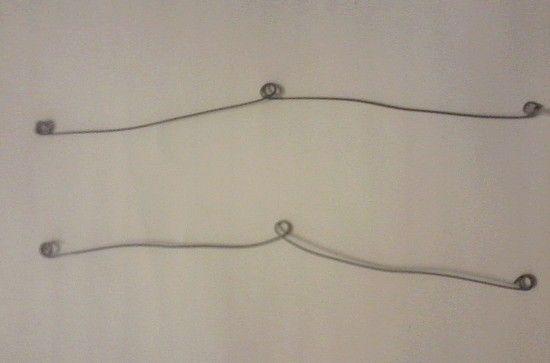
A simplified version of a do-it-yourself rocker arm
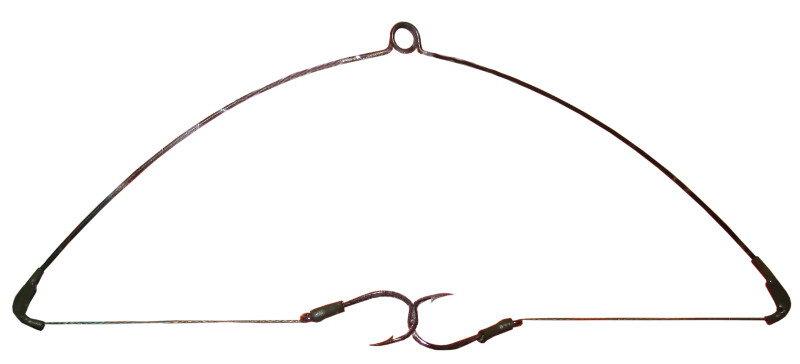
Tackle storage option
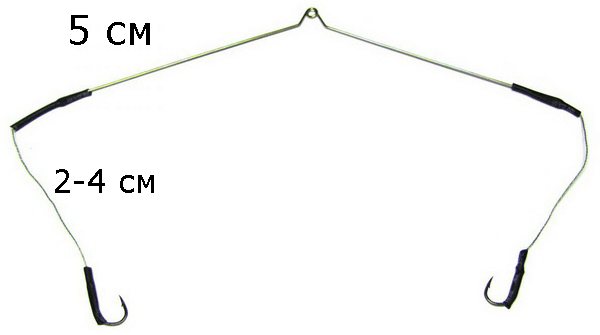
Leashes can be as small as 1 cm, but we recommend starting with two. There are several variations of the rocker , they differ in the material of manufacture:
- With sliding leashes . This bottom rig is positioned as the most sensitive, its leads are tied to the main thread through the end and central rings. When swallowing the bait, the bream does not feel any resistance and confidently pulls out the line. The bite signal is the float sinking and the nod bending towards the bottom.
- Blind equipment . The leashes are installed directly to the outer rings. When the bream begins to swallow the bait, one arm of the rig rises and the nod extends. A float placed on the surface of the water can also indicate a bite. Here it is very important to make the hook in a timely manner, otherwise the fish, feeling some resistance, may leave.
The success of ice fishing with a rocker depends on the correct manufacture of equipment and adherence to certain fishing techniques.
Video on how to make a rocker with your own hands
Fishing process
Hunting for bream in winter using a rocker is carried out at a depth of 7-15 m . First of all, they check channel dumps, holes, and coastal edges. The holes are drilled with a drill with a blade diameter of 200 mm . In order to avoid setting the bottom equipment by surprise when fishing, the fishing line should be kept closer to the edge when lifting the prey.
Catching bream on a yoke consists of the following steps:
- The bait is thrown into the drilled hole in half an hour using a feeder - a dump truck. It should deliver the mixture to the very bottom. In the absence of a current, it is enough to make a feed from several lumps of bait mixture thrown into the hole without a special device.
- Having put two types of bait on the hooks, make the first cast into the hole. Using the selection method, you will be able to determine the most advantageous bait option and settle on it.
- A straightened nod will indicate that the fish is trying the proposed bait; the hook is made when the arm of the bottom rig is lowered.
During the fishing process, it is recommended to use a hook.
Catching bream on a rocker, watch video
Lure
There will be no successful bream fishing without baiting and baiting. Establishing a fishing spot should be done a few days before the fishing session, allowing the object of the hunt to get used to the smell of the food and make sure that the feeding spot is safe. Bait for attaching and directly feeding fish at the time of fishing is made according to the same recipe.
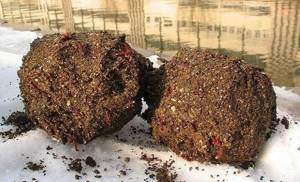
Methods of catching bream are based on the concentration of fish at a certain point, which can be done with bait that reaches the bottom and only then scatters over a certain zone, thus creating a contrasting spot different from the color of the bottom sediments. To obtain such qualities, the composition of the bait includes soil from chernozem and dried loam. The base of the mixtures is prepared from boiled millet or pearl barley porridge, adding pureed steamed peas and sunflower cake, bringing the composition to a thick and sticky consistency. To give the effect of dusting in water, complementary foods are supplemented with breadcrumbs and a small amount of mashed white bread crumb is included in the composition.
It is advisable to use natural ingredients as attractants, which include:
- table salt;
- sugar;
- cumin, anise or camphor oil;
- valerian;
- young, unthickened honey.
One of the latest discoveries of the bream fish was finding out the secret of how fish show interest in the smell of coffee. Coffee cake obtained as a result of preparing the drink in coffee machines has become an excellent additive in complementary foods that collect bream at the fishing point.
Important! The supply of complementary food is carried out by the formation of hard balls the size of an orange, compressed with such force that will allow the mixture to reach the bottom and only begin its destruction as a result of hitting the ground.
How to catch bream
There are two main directions of bream fishing: bottom and float fishing. You can catch bream using both the first and second methods throughout the year, including the possibility of fishing from ice, making allowances only for the selection of a certain size and type of fishing rod. Float rigs are mounted on fly, Bologna and match fishing rods. Bottom fishing is carried out by equipping spinning rods in special ways, which among fishermen are called zakidukhs, using feeder equipment, using classic bottom tackle in the form of a rubber donkey or a net.
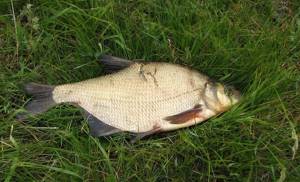
Due to the peculiarities of installing rigs based on the conditions of the chosen fishing location, bream fishing is carried out both from the shore and from a boat. The wariness of the fish forces the fisherman to use delicate gear using fishing lines of maximum diameter, which places special demands on equipping fishing rods with reels with precise adjustment of the friction and the use of shock-absorbing devices in the form of feedergam on the gear.
In summer, you need to catch bream from the shore in an extremely quiet environment, avoiding unnecessary activity that causes noise and unnecessary splashes in the water. Approaches to fishing spots from a boat should be made at a slow speed and against the current. Even with all the precautions and care taken by the fisherman, bream begins to bite at the fishing site an hour or even more after the placement and installation of gear.
How to catch bream from the shore in summer
Fishing from the shore is more successful using bottom gear at long distances, since fish in rare cases can come close to the coastlines. The strategy of ambush fishing over several days will be the most acceptable option to obtain a significant result. Fishing for bream on the river in summer begins with the intensive formation of a feeding spot and the subsequent installation of rigs. On the shore, from five to ten casters are installed on flyers, delivering baits to the fishing zone and equipping the rods with sound alarms.
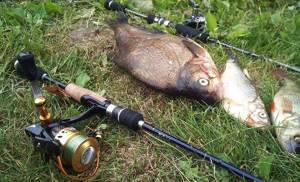
The fishing session should continue during both daylight and darkness. The nozzles are checked only after bites, trying once again not to create noise. The supply of bait is carried out after landing the caught fish, knowing that the school has temporarily moved away from the fishing point due to the noise of the fight with the caught fish. The bream bite is sharp, with a strong pull on the line, which requires immediate hooking. Fishing is complex, characterized by strong resistance from the fish at the initial stage, until it rises to the surface of the water. After rising to the surface, as fishermen say, the fish is testing the air, the trophy calms down and, lying on its side, is pulled to the shore, where it is brought into the landing net.
Read more about the tactics and techniques of catching bream on a feeder and preparing equipment.
How to properly catch bream from a boat
It is easier for an angler to reach a promising place from a boat, so fly or Bolognese tackle becomes a priority in the hunt for a trophy. Bait is fed into the fed area, trying to keep the bait a couple of centimeters from the bottom. The wait for a bite can last from ten minutes to two hours. The bite looks like a slow movement of the float to the side and its subsequent ascent, as the floaters say at this moment - the float is down. The float signal indicates immediate hooking. The ring fishing method will help you catch bream in the current. This bottom rig is installed from a tightly moored boat a couple of tens of meters from the bait supply point. Bait floating with the current, released from a boat, attracts fish to the bait with a cloudy trail. This method is used to fish deep riverbed holes, mainly hunting for trophy specimens of bream.
Habitat
Bream lives in almost all water bodies of the CIS countries. Its presence was also noticed among fishermen in the Aral and Caspian Seas. The individual is a fairly common individual; a place for capture can be found in any nook of a reservoir. Favorite habitats are where the waters are calm and there is a lot of shell rock. In areas of mountain rivers, it is useless to look for this specimen; the rocky bottom and stormy conditions are not for bream, since the fish loves moderate water elements, where there are quiet, deep places with a reverse whirlpool and a slight current. Unacceptable places and with cold water, the fish avoids such waters. It is better to fish in places where the bed of a river or flowing lake consists of a sandy-clayey or silty bottom with shell rock.
The individual feeds on both algae and its diet includes mollusks. Also don't mind trying crustaceans. There have been cases when a fish pulled a crayfish out of a hole at a time when the crayfish's shell was at the molting stage. It is worth noting the fact that the fish is quite smart in its own way, so it is quite timid.
Read: Bream
There have been cases among experienced fishermen when, during the catch, when the bream was spawning, they had to talk in a whisper! Otherwise, the fish changed their locations. From this it is concluded that it is necessary to fish in silence and not stir up the water, creating a huge amount of splashes.
You can’t name a specific location for bream; everything depends on the time of year. In hot weather or severe frost, schools of bream stay closer to the shore, as there is more food there. From this it is worth drawing a conclusion; You can catch an individual using bottom tackle or a float rod. It is worth noting that the bite of bream on a float is very careful and almost invisible. Therefore, you should pay close attention to the bite, otherwise you may not hook it, and the fish will spit out the bait. If hooked, the bream usually does not resist; at the beginning of fishing, it hangs on the hook like a “log”; even an experienced fisherman may not feel that the trophy is already sitting.
It’s worth choosing almost any time of day to catch bream. But there is one point, if this is the day, you need to look for bream at depth in holes, slopes, and edges. And at night -
Near the shore and in shallow areas of rivers and reservoirs.
It’s good when you have information about the bottom topography, or have studied it using an echo sounder. Places of holes and drops, which are connected by several small areas. This is an ideal place for feeder fishing and is ideal for a bait table. In order to feed the bream.

